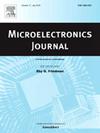基于28nm CMOS的14位2.6GS/s射频采样流水线ADC
IF 1.9
3区 工程技术
Q3 ENGINEERING, ELECTRICAL & ELECTRONIC
引用次数: 0
摘要
提出了一种基于28纳米CMOS工艺的14位2.6 GS/s流水线ADC。它采用4通道交错流水线架构,在后台校准偏移、增益和时序失配误差。移除了输入缓冲器,以节省电力和降低噪音。为了放松对ADC驱动的要求,采样电容和DAC电容被拆分,以减少非线性回退。为了进一步降低功耗,剩余放大器采用P/N互补输入结构,参考缓冲器采用推挽结构,并在4个子adc通道之间共享。对于140 MHz的输入信号,该ADC的信噪比为60.2dBFS, SFDR为70dBc。当输入频率增加到2.5 GHz时,动态性能降至51dBFS, SFDR降至50.7 dB。该ADC可直接对5.5 GHz射频输入进行采样,并在−55°C - 125°C的温度范围和500 MS/s ~ 3 GS/s的采样率下保持稳定的性能。在0.9V/1.8V电源下,ADC功耗为980 mW,有效面积为6 mm2。本文章由计算机程序翻译,如有差异,请以英文原文为准。
A 14-bit 2.6GS/s RF sampling pipelined ADC in 28nm CMOS
A 14-bit 2.6 GS/s pipelined ADC in 28 nm CMOS process is presented in this paper. It employs 4-channel interleaved pipelined architecture, where offset, gain and timing mismatch errors are calibrated in background. Input buffer is removed to save power and reduce noise. To relax the ADC driving requirement, the sampling and DAC capacitors are split to reduce nonlinear kick-back. To further reduce power, the residue amplifier employs a P/N complemented input structure and the reference buffer employs a push-pull structure, and they are shared between the 4 sub-ADC channels. This ADC achieves an SNR of 60.2dBFS, an SFDR of 70dBc for 140 MHz input signal. The dynamic performance decreases to 51dBFS SNR and 50.7 dB SFDR when input frequency increases to 2.5 GHz. The ADC can sample 5.5 GHz RF input directly, and maintains stable performance through −55 °C–125 °C temperature range and 500 MS/s ∼3 GS/s sample rate. The ADC consumes 980 mW under 0.9V/1.8V supply and occupies an active area of 6 mm2.
求助全文
通过发布文献求助,成功后即可免费获取论文全文。
去求助
来源期刊

Microelectronics Journal
工程技术-工程:电子与电气
CiteScore
4.00
自引率
27.30%
发文量
222
审稿时长
43 days
期刊介绍:
Published since 1969, the Microelectronics Journal is an international forum for the dissemination of research and applications of microelectronic systems, circuits, and emerging technologies. Papers published in the Microelectronics Journal have undergone peer review to ensure originality, relevance, and timeliness. The journal thus provides a worldwide, regular, and comprehensive update on microelectronic circuits and systems.
The Microelectronics Journal invites papers describing significant research and applications in all of the areas listed below. Comprehensive review/survey papers covering recent developments will also be considered. The Microelectronics Journal covers circuits and systems. This topic includes but is not limited to: Analog, digital, mixed, and RF circuits and related design methodologies; Logic, architectural, and system level synthesis; Testing, design for testability, built-in self-test; Area, power, and thermal analysis and design; Mixed-domain simulation and design; Embedded systems; Non-von Neumann computing and related technologies and circuits; Design and test of high complexity systems integration; SoC, NoC, SIP, and NIP design and test; 3-D integration design and analysis; Emerging device technologies and circuits, such as FinFETs, SETs, spintronics, SFQ, MTJ, etc.
Application aspects such as signal and image processing including circuits for cryptography, sensors, and actuators including sensor networks, reliability and quality issues, and economic models are also welcome.
 求助内容:
求助内容: 应助结果提醒方式:
应助结果提醒方式:


